|
 |
Historical
Markers of Sabine County, Texas |
 |
| |
Marker
Photo |
Marker
Name & Text
|
|
| |
Clark-Dickey
and Smith Cemeteries
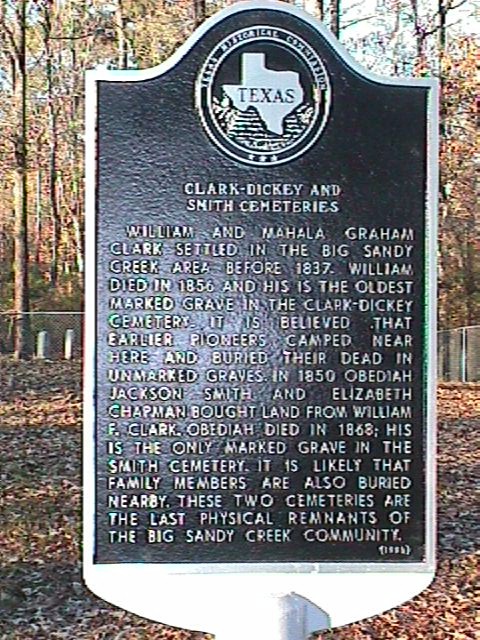
|
William
and Mahala Graham Clark settled in the Big Sandy Creek area
before 1837. William died in 1856 and his is the oldest marked
grave in the Clark-Dickey Cemetery. It is believed that earlier
pioneers camped near here and buried their dead in unmarked
graves. In 1850 Obediah
Jackson Smith and Elizabeth Chapman bought land from William
F. Clark. Obediah died in 1868; his is the only marked grave
in the Smith Cemetery. It is likely that family members are also
buried nearby. These two cemeteries are the last physical remnants
of the Big
Sandy Creek community.
Erected 1996
|
|
| |
Dennis Cemetery
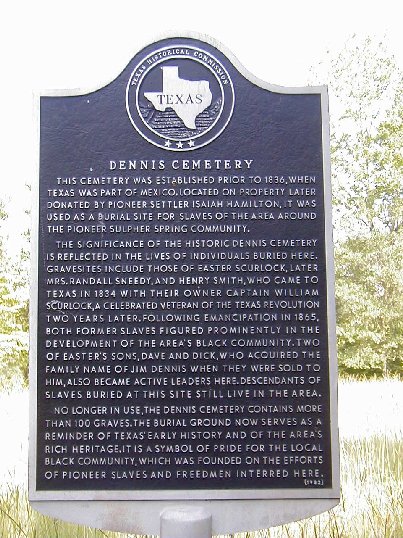
|
This
cemetery was established prior to 1836 when Texas was part of
Mexico. Located on property later donated by pioneer settler
Isaiah Hamilton, it was used as a burial site for slaves of the
area around the pioneer Sulphur Spring community. The significance
of the historic Dennis Cemetery is reflected in the lives of
individuals buried here. Gravesites include those of Easter
Scurlock, later Mrs. Randall Sneedy, and Henry Smith, who came to
Texas in 1834 with their owner Captain
William Scurlock, a celebrated veteran of the Texas Revolution
two years later. Following Emancipation in 1865, both former
slaves figured prominently in the development of the area's black
community. Two of Easter's sons, Dave and Dick, who acquired the
family name of Jim Dennis when they were sold to him, also became
active leaders here. Descendants of slaves buried at this site
still live in the area. No longer in use, the Dennis Cemetery
contains more than 100 graves. The burial ground now serves as a
reminder of Texas' early history and of the area's rich heritage.
It is a symbol of pride for the local black community, which was
founded on the efforts of pioneer slaves and Freedmen interred
here.
Erected 1982 [see William
Scurlock - Tx Handbook Online]
|
|
| |
County Line Baptist
Church and Cemetery 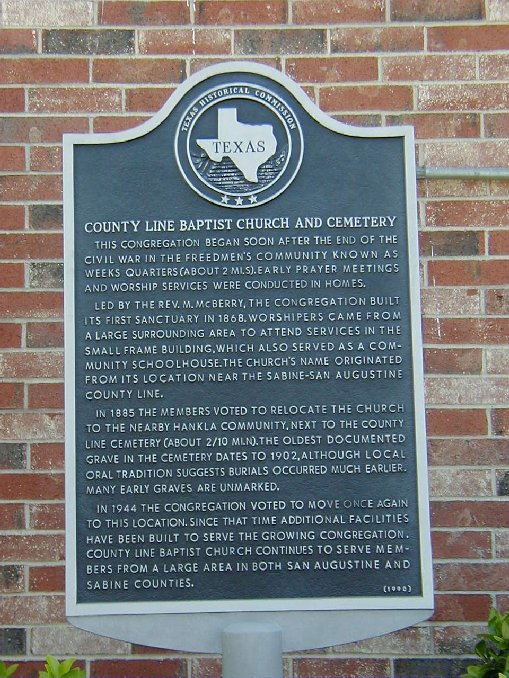
|
This
congregation began soon after the end of the Civil War in the
Freedmen's community known as Weeks Quarters (about 2 mi. S).
Early prayer meetings and worship services were conducted in
homes. Led by the Rev. M. McBerrry, the congregation built its
first sanctuary in 1868. Worshipers came from a large surrounding
area to attend services in the small frame building, which also
served as a community schoolhouse. The church's name originated
from its location near the Sabine-San Augustine County line. In
1885 the members voted to relocate the church to the nearby Hankla
community, next to the County Line Cemetery (about 2/10 mi. N).
The oldest documented grave in the cemetery dates to 1902,
although local oral tradition suggests burials occurred much
earlier. Many early graves are unmarked. In 1944 the congregation
voted to move once again to this location. Since that time
additional facilities have been built to serve the growing
congregation. County Line Baptist Church continues to serve
members from a large area in both San Augustine and Sabine
counties.
Erected 1990
|
|
| |
Site of East Mayfield
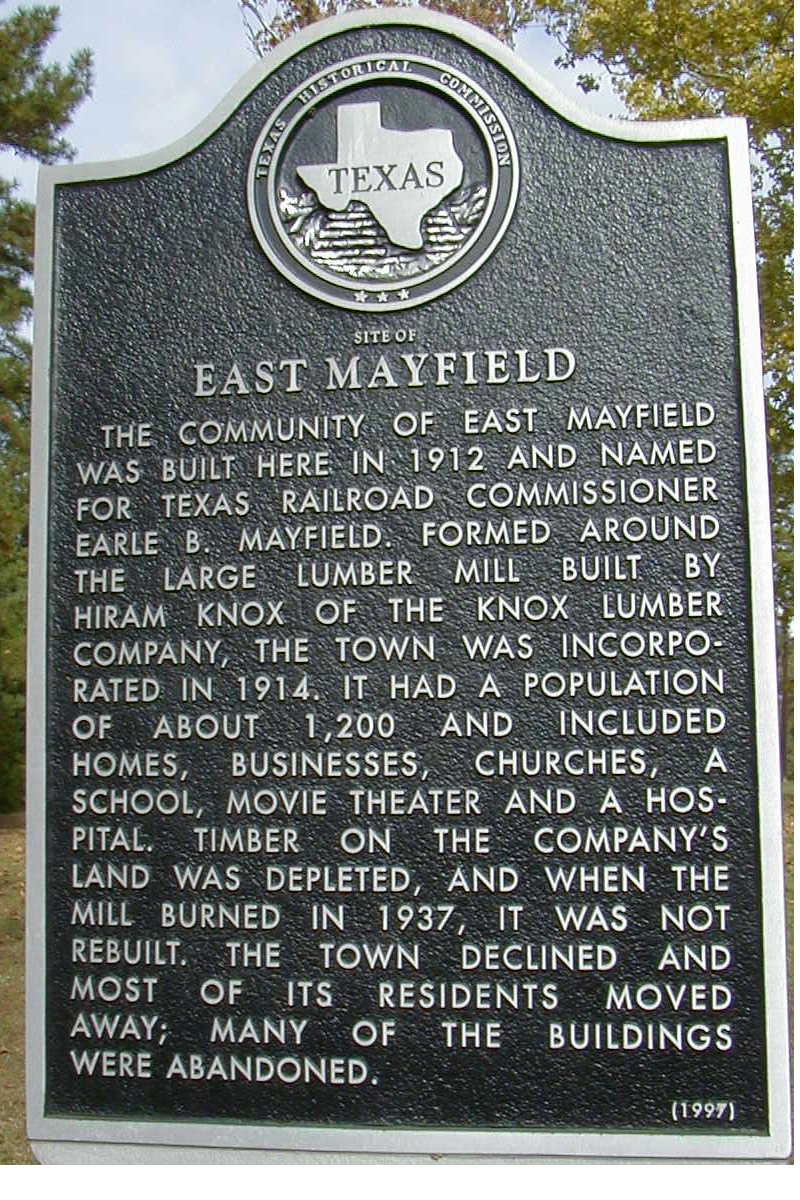
|
The
community of East
Mayfield was built here in 1912 and named for Texas Railroad
Commissioner Earle
B. Mayfield. Formed around the large lumber mill built by
Hiram Knox of the Knox Lumber Company, the town was incorporated
in 1914. It had a population of about 1,200 and included homes,
businesses, churches, a school, movie theater and a hospital.
Timber on the company's land was depleted, and when the mill
burned in 1937, it was not rebuilt. The town declined and most of
its residents moved away; many of the buildings were abandoned.
LOCATION: Hemphill - Edwards and Ball Park St. -- Erected 1997
|
|
| |
El Lobanillo
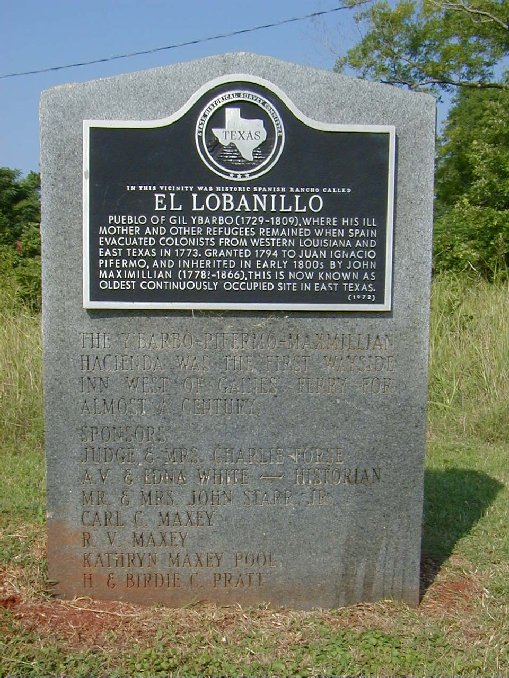
|
In
this vicinity was historic Spanish rancho called El Lobanillo.
Pueblo of Gil Ybarbo (1729-1809), where his ill mother and other
refugees remained when Spain evacuated colonists from western
Louisiana and east Texas in 1773. Granted 1794 to Juan Ignacio
Pifermo, and inherited in early 1800s by John Maximillian
(1778?-1866), this is now known as oldest continuously occupied
site in east Texas.
LOCATION: Town of Geneva -- Erected 1972
[Additional
information Handbook of Texas]
|
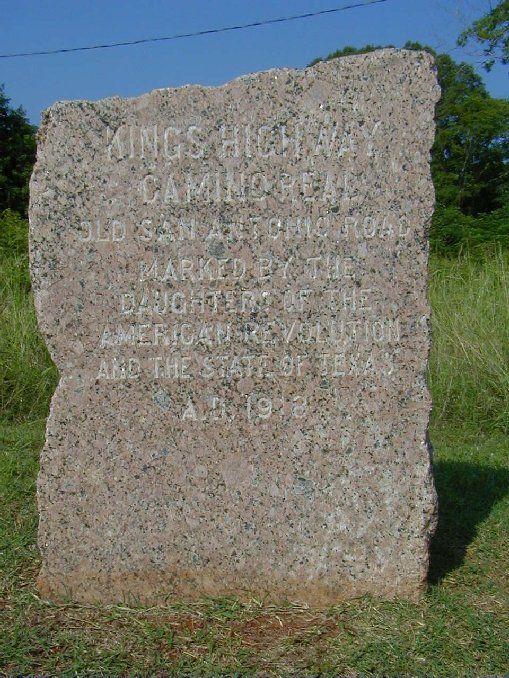
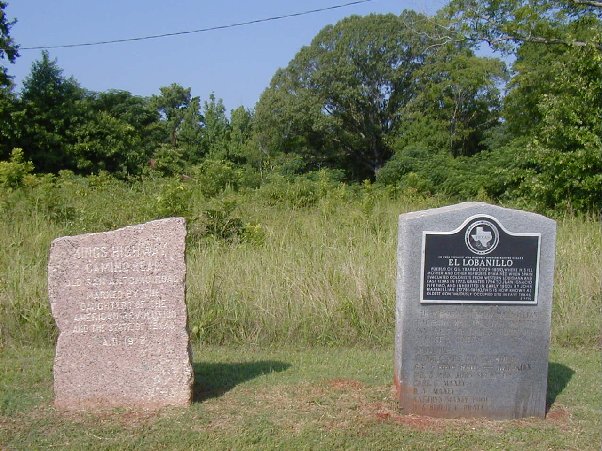
|
|
| |
Gaines
Memorial Bridge
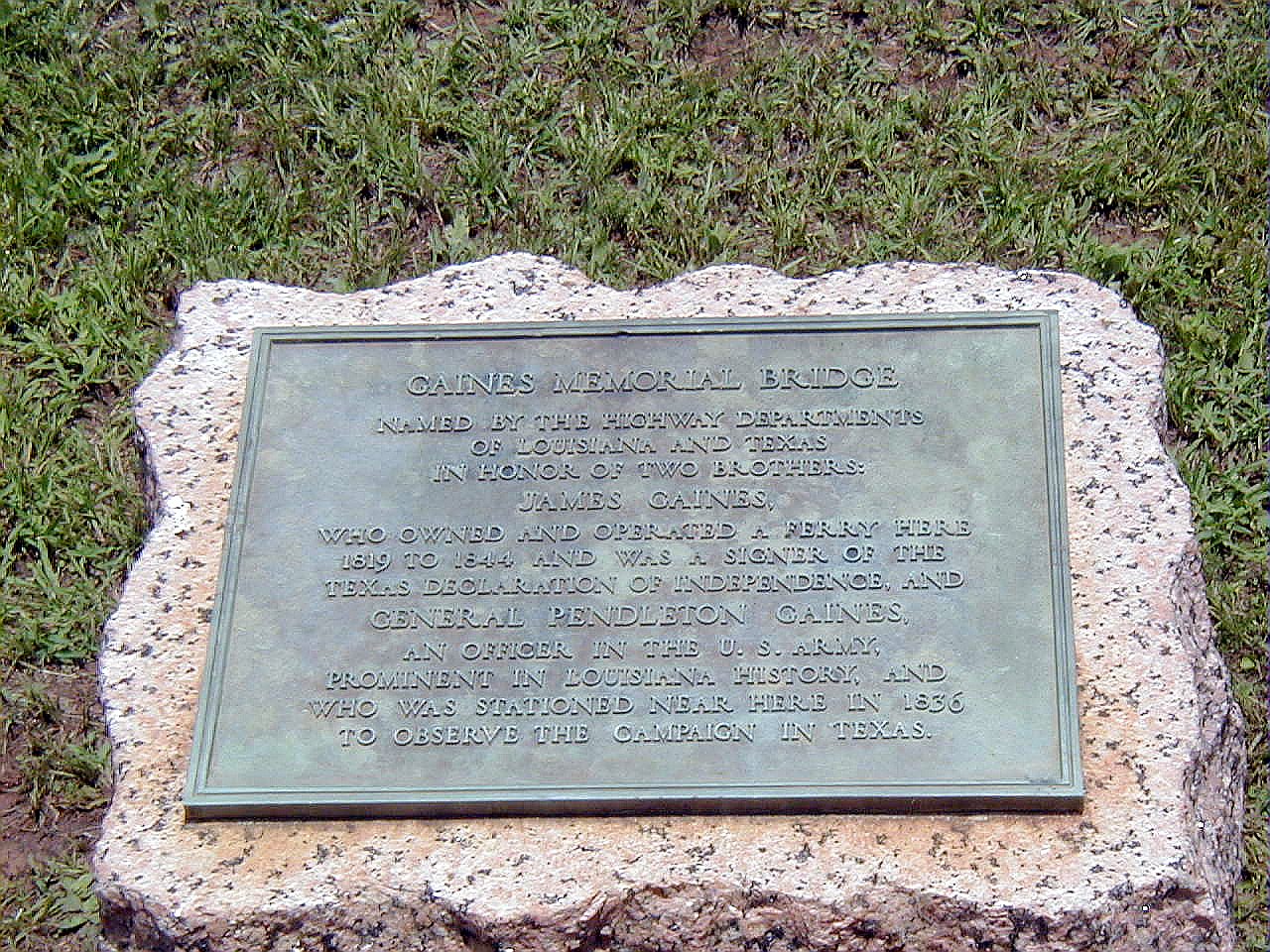
|
LOCATION: SH 21,
Texas/Louisiana border - Toledo Bend
|
|
| |
William
Gasby Cemetery
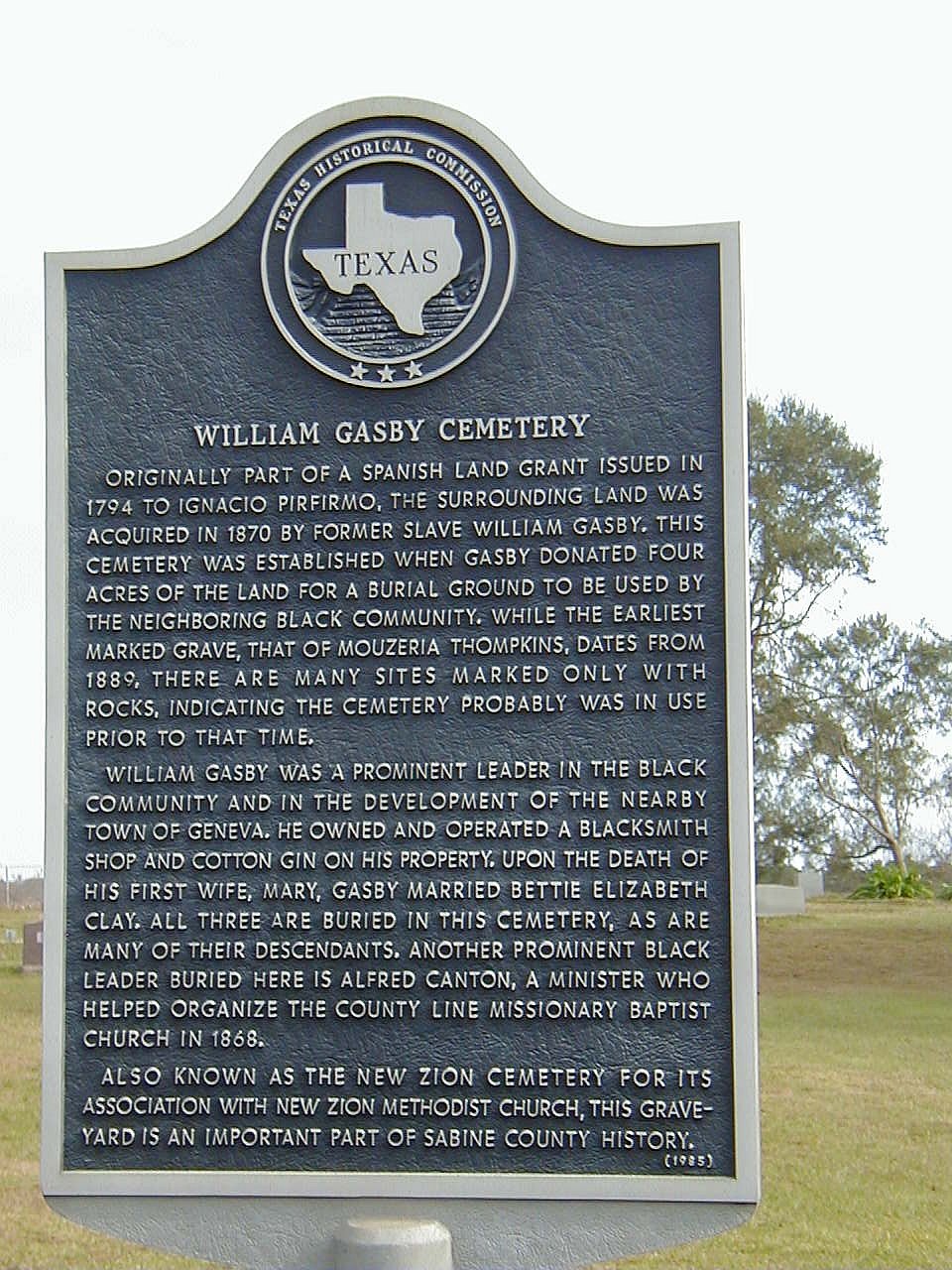
|
Originally
part of a Spanish land grant issued in 1794 to Ignacio Pirfirmo,
the surrounding land was acquired in 1870 by former slave William
Gasby. This cemetery was established when Gasby donated four acres
of the land for a burial ground to be used by the neighboring
black community. While the earliest marked grave, that of Mouzeria
Thompkins, dates from 1889, there are many sites marked only with
rocks, indicating the cemetery probably was in use prior to that
time. William Gasby was a prominent leader in the black community
and in the development of the nearby town of Geneva. He owned and
operated a blacksmith shop and cotton gin on his property. Upon
the death of his first wife, Mary, Gasby married Bettie Elizabeth
Clay. All three are buried in this cemetery, as are many of their
descendants. Another prominent black leader buried here is Alfred
Canton, a minister who helped organize the County Line Missionary
Baptist Church in 1868. Also known as the New Zion Cemetery for
its association with New Zion Methodist Church, this graveyard is
an important part of Sabine County history.
LOCATION: Town of Geneva -- Erected 1985
|
|
| |
Gellatly
Family Cemetery
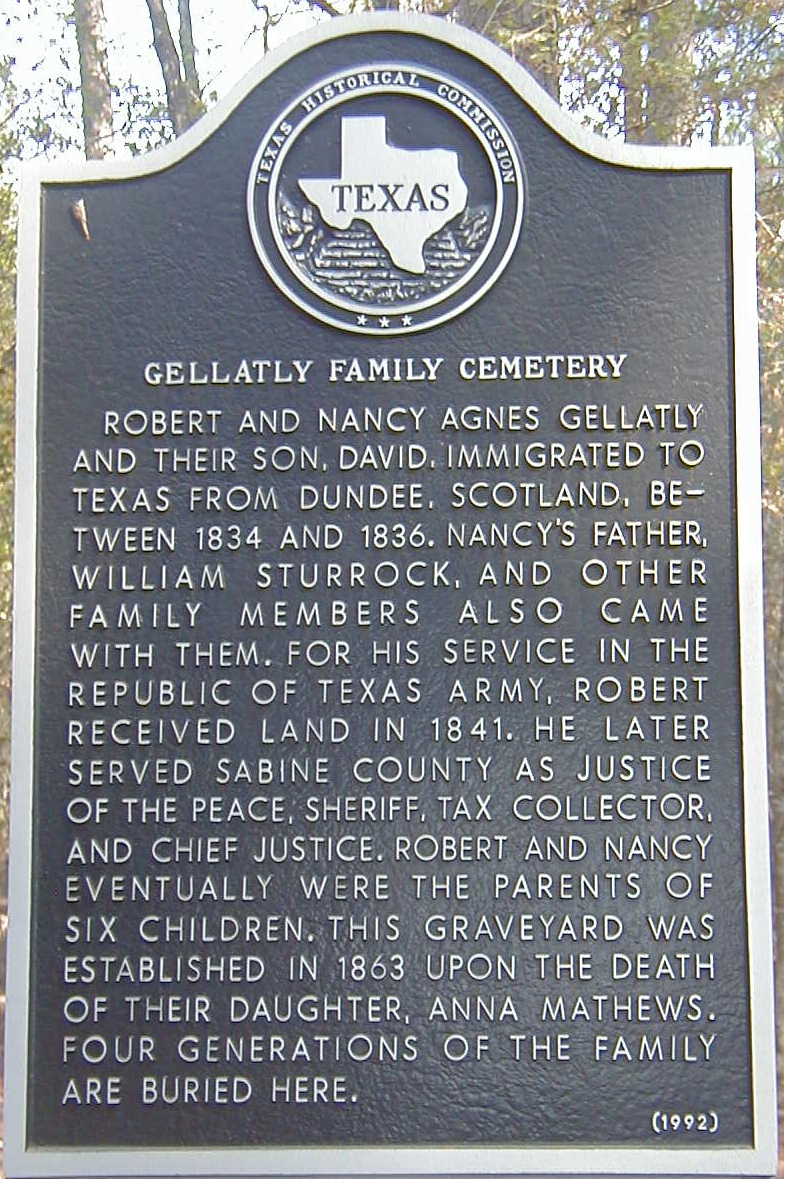
|
Robert
and Nancy Agnes Gellatly and their son, David, immigrated to Texas
from Dundee, Scotland, between 1834 and 1836. Nancy's father,
William Sturrock, and other family members also came with them.
For his service in the Republic of Texas army, Robert received
land in 1841. He later served Sabine County as justice of the
peace, sheriff, tax collector, and chief justice. Robert and Nancy
eventually were the parents of six children. This graveyard was
established in 1863 upon the death of their daughter, Anna
Mathews. Four generations of the family are buried here.
LOCATION: Town of Milam -- Erected 1992
|
|
| |
Hemphill
Cemetery

|
The
burials in this cemetery reflect the early history of Hemphill
as a developing commercial center and seat of government. The
oldest marked grave dates from 1867, nine years after the town was
founded. The earliest gravestone marks the burial site of pioneer
settler Marier C. Morris (1845-1867), the daughter of Jubal H.
Ragan, an early area physician. Early records of the cemetery were
lost in an 1875 Courthouse fire, but it is believed the original
tract of land for the burial ground was donated by Simon Newsome
Beckcom and William T. Morris. The site was later enlarged by
additional donations of property. The first school in the area,
the Sabine
Valley Institute, was located in a Masonic Lodge building on
adjacent land which was also used for early religious services.
Burials here include those of pioneer area settlers, prominent
local merchants and businessmen, veterans of several wars, early
leaders of the community, and elected officials of the city,
county, and district levels of government. Also interred here is
Simeon R. Williams, who served this area as a state legislator.
Still in use, the historic Hemphill Cemetery serves as a reminder
of the area's rich heritage.
LOCATION: Town of Hemphill -- Erected 1981
|
|
| |
Las Borregas
Camp Site
|
Las
Borregas Creek formed east line of Spain's 1794 grant to J. I.
Pifermo, first landowner in present Sabine County. Upstream, about
1800 at Jack Cedar Crossing of Crow Ferry Road, Spain had an army
post to protect settlers and travel. The "Father of
Texas," Stephen
F. Austin, spent his first night (July 16, 1821) in Texas on
this creek.
LOCATION: Town of Milam -- Erected 1973
|
|
| |
Isaac Low
Cemetery
|
A
veteran of the War of 1812, Isaac
Low (1781-1853) migrated to this area from Tennessee in 1828.
During the Texas Revolution he operated a nearby ferry across the
Sabine River to aid settlers fleeing from the advancing Mexican
army. He later served as a commissioner for Sabine County. His son
Jesse Low (1812-1848), whose grave is the earliest marked at this
site, donated the land for use as a cemetery. Also buried here are
Reddick Pitt Sibley, a captain during the Civil War, and Eli Low,
whose 1883 murder resulted in a three-year feud in the surrounding
area.
LOCATION: 15 mi. east of Hemphill via FM 83, then south on FM
3382 to E 3520, in El Camino Bay subdivision -- Erected 1981
|
|
| |
Barney C. Lowe
|
Grave Marker
LOCATION: Lowe Family Cemetery about 5 mi. south of Pineland on
US 96, then east on Lowe Cemetery Rd. on right -- Erected 1936
|
|
| |
Macedonia
Baptist Church Cemetery
|
The
Macedonia Baptist Church was established on this site in 1885.
Though it is likely that there are burials dating from that time,
the earliest marked grave is that of Olin Robertson (1828-1906).
Ten graves are those of World War I veterans, and more than 35 are
those of veterans of World War II. Other wars and conflicts are
represented as well. Four of those interred here in the 1970s
lived more than 100 years. Many burials are those of persons born
into slavery who lived to pave the way to freedom for succeeding
generations of African Americans. There are more than 500 graves
on this site. Of these, about 193 are unmarked. The high number of
early unmarked graves is one reflection of the social and economic
status of black people in this area at the turn of the 20th
century. The cemetery is a chronicle of African American heritage.
LOCATION: 2 miles east of Hemphill on FM 83 -- Erected 2000
|
|
| |
McGown
Cemetery
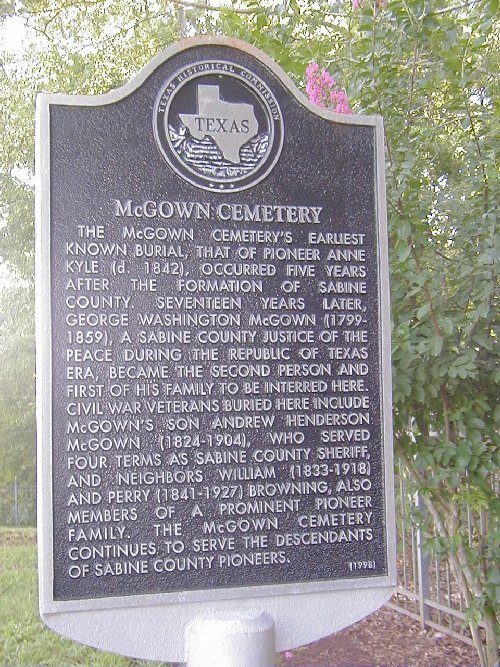
|
The
McGown Cemetery's earliest known burial, that of pioneer Anne Kyle
(d. 1842) occurred five years after the formation of Sabine
County. Seventeen years later, George Washington McGown
(1799-1859), a Sabine County justice of the peace during the
Republic of Texas era, became the second person and first of his
family to be interred here. Civil War veterans buried here include
McGown's son Andrew Henderson McGown (1824-1904), who served four
terms as Sabine County sheriff, and neighbors William (1833-1918)
and Perry (1841-1927) Browning, also members of a prominent
pioneer family. The McGown Cemetery continues to serve the
descendants of Sabine County pioneers.
LOCATION: 3 mi. W of Milam on SH 21, then .4 mi. N on unmarked
cemetery road -- Erected 1998
|
|
| |
McMahan's
Chapel
|
LOCATION: Monument
- 10.5 mi. NW of Milam along SH 21, then south on Spur 35 --
Erected 1936
|
|
| |
Meador
Cemetery
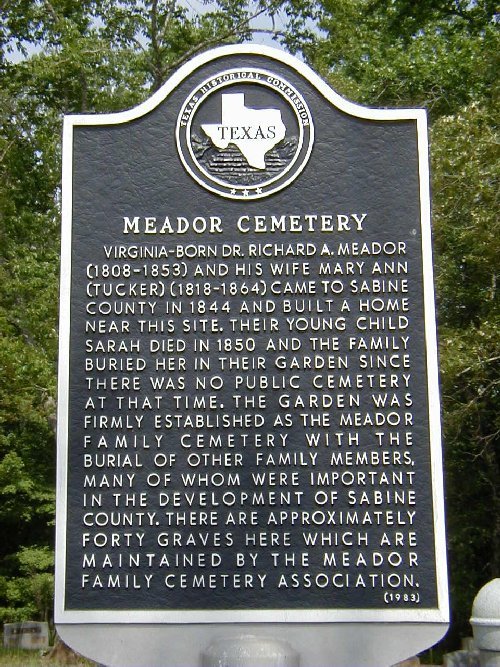
|
Virginia-born
Dr. Richard A. Meador (1808-1853) and his wife Mary Ann (Tucker)
(1818-1864) came to Sabine County in 1844 and built a home near
this site. Their young child Sarah died in 1850 and the family
buried here in their garden since there was no public cemetery at
that time. The garden was firmly established as the Meador Family
Cemetery with the burial of other family members, many of whom
were important in the development of Sabine County. There are
approximately forty graves here which are maintained by the Meador
Family Cemetery Association.
LOCATION: north of Milam off SH 87 on Meador Cemetery Lane --
Erected 1983
|
|
| |
Town of Milam
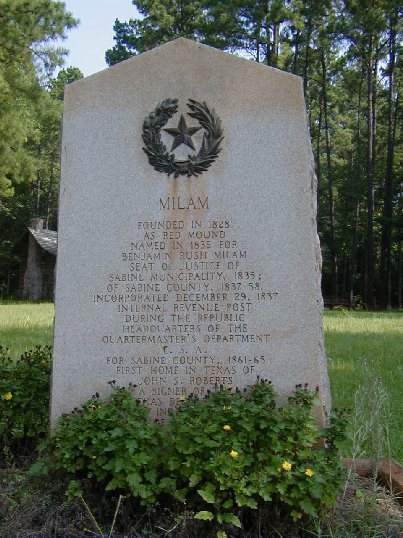
|
Founded
in 1828 as Red Mound. Named in 1835 for Benjamin
Rush Milam. Seat of justice of Sabine municipality, 1835, of
Sabine County, 1837-58. Incorporated December 29, 1837. Internal
Revenue post during the Republic headquarters of the
Quartermaster's Department, C. S. A. for Sabine County, 1861-65.
First home in Texas of John
S. Roberts, a signer of the Texas Declaration of Independence.
Home of John
C. Hale, martyr of San Jacinto.
LOCATION: Town of Milam - SH 21 in front of Milam Post Office
-- Erected 1936
|
|
| |
Milam
Masonic Institute
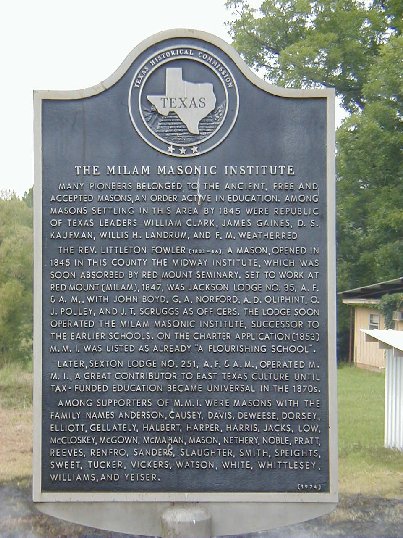
|
Many
pioneers belonged to the Ancient, Free and Accepted Masons, an
order active in education. Among Masons settling in this area by
1845 were Republic of Texas leaders William Clark, James
Gaines, D.
S. Kaufman, Willis
H. Landrum, and F.
M. Weatherred. The Rev.
Littleton Fowler (1803-46), a Mason, opened in 1845 in this
county the Midway Institute, which was soon absorbed by Red Mount
Seminary. Set to work at Red Mount (Milam), 1847, was Jackson
Lodge No. 35, A. F. & A. M., with John Boyd, G. A. Norford, A.
D. Oliphint, O. J. Polley, and J. T. Scruggs as officers. The
lodge soon operated the Milam Masonic Institute, successor to the
earlier schools. On the charter application (1853) M. M. I. was
listed as already "a flourishing school." Later, Sexton
Lodge No. 251, A. F. & A. M., operated M. M. I., a great
contributor to East Texas culture until tax-funded education
became universal in the 1870s. Among supporters of M. M. I. were
masons with the family names Anderson, Causey, Davis, Deweese,
Dorsey, Elliott, Gellately, Halbert, Harper, Harris, Jacks, Low,
McCloskey, McGown, McMahan, Mason, Nethery, Noble, Pratt, Reeves,
Renfro, Sanders, Slaughter, Smith, Speights, Sweet, Tucker,
Vickers, Watson, White, Whittlesey, Williams, and Yeiser.
LOCATION: Town of Milam - east of SH 87 and SH 21 intersection
-- Erected 1974
|
|
| |
New
Hope-Bethel Baptist Church
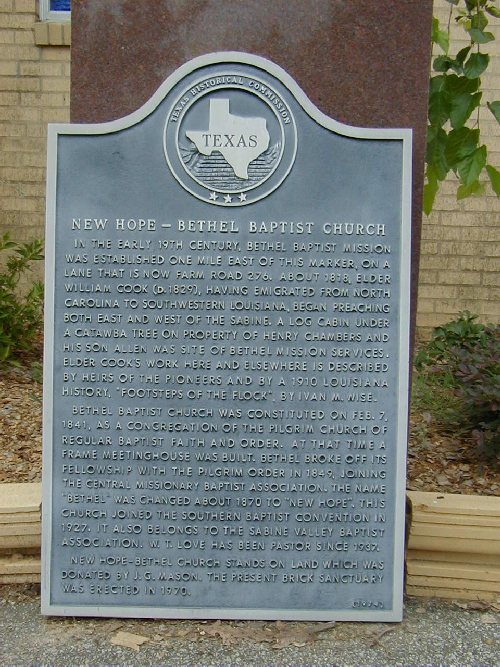
|
In
the early 19th century, Bethel Baptist Mission was established one
mile east of this marker, on a lane that is now Farm Road 276.
About 1818, Elder William Cook (d. 1829), having emigrated from
North Carolina to southwestern Louisiana, began preaching both
east and west of the Sabine. A log cabin under a catawba tree on
property of Henry Chambers and his son, Allen, was site of Bethel
Mission services. Elder Cook's work here and elsewhere is
described by heirs of the pioneers and by a 1910 Louisiana
history, "Footsteps of the Flock," by Ivan M. Wise.
Bethel Baptist Church was constituted on Feb. 7, 1841, as a
congregation of the Pilgrim Church of Regular Baptist Faith and
Order. At that time a frame meetinghouse was built. Bethel broke
off its fellowship with the Pilgrim Order in 1849, joining the
Central Missionary Baptist Association. The name
"Bethel" was changed about 1870 to "New Hope."
This church joined the Southern Baptist Convention in 1927. It
also belongs to the Sabine Valley Baptist Association. W. T. Love
has been pastor since 1937. New Hope-Bethel Church stands on land
which was donated by J. G. Mason. The present brick sanctuary was
erected in 1970.
LOCATION: north of Milam via SH 87 about 4.5 mi., then east on
New Hope Baptist Rd. -- Erected 1974
|
|
| |
Oliphint
Chapel Cemetery
|
Alfred
D. Oliphint came to Texas and received land grants in 1839 and
1844 in Sabine County. He served as justice of the peace and
county judge, and in 1879 deeded five acres of land to the
Methodist Episcopal Church. This cemetery, located adjacent to the
church, dates to at least 1870. Among those interred here are
early settlers to the area, many of whom are buried in unmarked
graves. The restored cemetery continues to serve the community and
is maintained by the Oliphint Chapel Memorial Gardens Association.
LOCATION: inside Frontier Park, SH 21 and Toledo Bend - Milam
-- Erected 1997
|
|
| |
Matthew
Arnold Parker
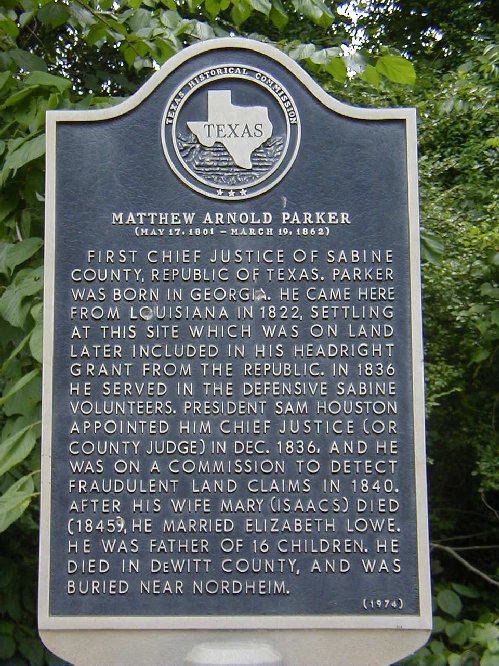
|
(May
17, 1801 - March 19, 1862) First chief justice of Sabine County,
Republic of Texas. Parker
was born in Georgia. He came here from Louisiana in 1822, settling
at this site which was on land later included in his headright
grant from the Republic. In 1836 he served in the Defensive Sabine
Volunteers. President Sam Houston appointed him chief justice (or
county judge) in Dec. 1836, and he was on a commission to detect
fraudulent land claims in 1840. After his wife Mary (Isaacs) died
(1845), he married Elizabeth Lowe. He was father of 16 children.
He died in DeWitt County, and was buried near Nordheim.
LOCATION: 4 mi. north of Hemphill on SH 87 -- Erected
1974
|
|
| |
Payne-Williams
Cemetery
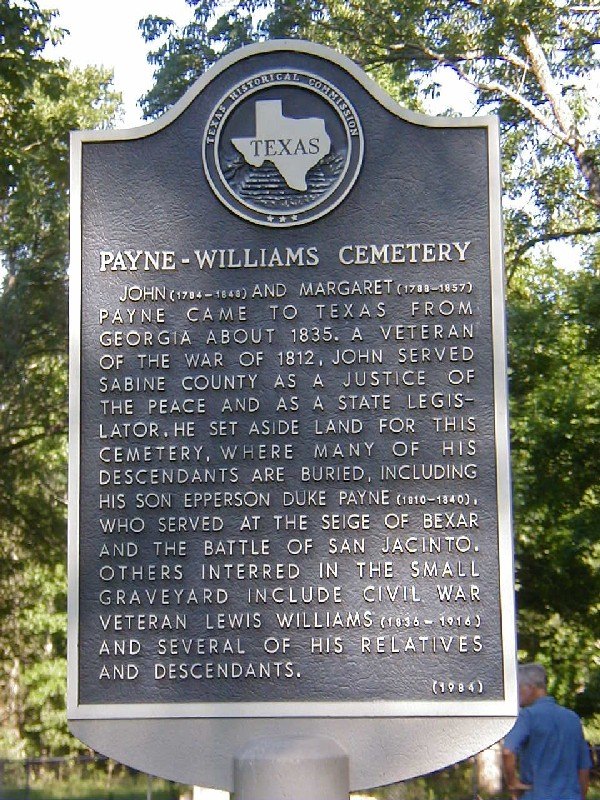
|
John
(1784-1848) and Margaret (1788-1857) Payne came to Texas from
Georgia about 1835. A veteran of the War of 1812, John served
Sabine County as a justice of the peace and as a state legislator.
He set aside land for this cemetery, where many of his descendants
are buried, including his son Epperson Duke Payne (1810-1840), who
served at the Siege of Bexar and the Battle of San Jacinto. Others
interred in the small graveyard include Civil War veteran Lewis
Williams (1836-1916) and several of his relatives and descendants.
LOCATION: Town of Geneva -- Erected 1984
|
|
| |
Sabine
County
|
LOCATION: on the
Courthouse Square -- Erected 1936
|
|
| |
Sabine
County Courthouse
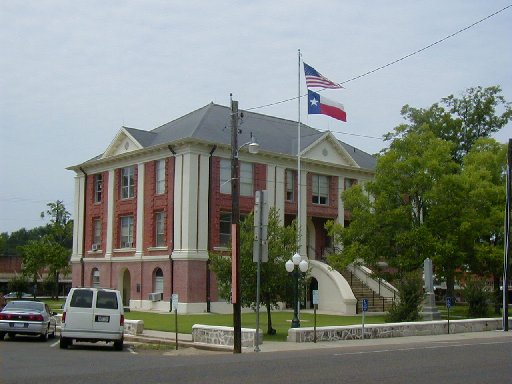
|
An
1858 election called for Sabine County offices to be moved from Milam
(7 mi. N) to this more central location. The new county seat, Hemphill,
was named for former Texas Supreme Court Justice John
Hemphill. The first courthouse at this site burned in 1875 and
was replaced by a larger frame structure. The present building was
started in 1906 by N. A. Dawson under the direction of James
Barney Lewis. The two floors were rebuilt following a fire in 1909
and a remodeling of the structure was completed in 1938 by the Works
Progress Administration.
LOCATION: on the Courthouse Square -- Erected 1982
|
|
| |
Sabine County
Jail

|
Sabine
County Commissioners contracted for this two-story Victorian jail
building in 1903. It was completed the following year during the
county judgeship of James T. Peace. Bricks for the exterior were
supplied from the local kiln of Henry Huffman. The original
interior space, which included an area for hangings, was remodeled
in 1925 by the Southern Steel Company of San Antonio. W. H.
Davidson was county judge at the time.
Recorded Texas Historic Landmark - 1980
LOCATION: on the Courthouse Square -- Erected 1980
|
|
| |
SabineTown
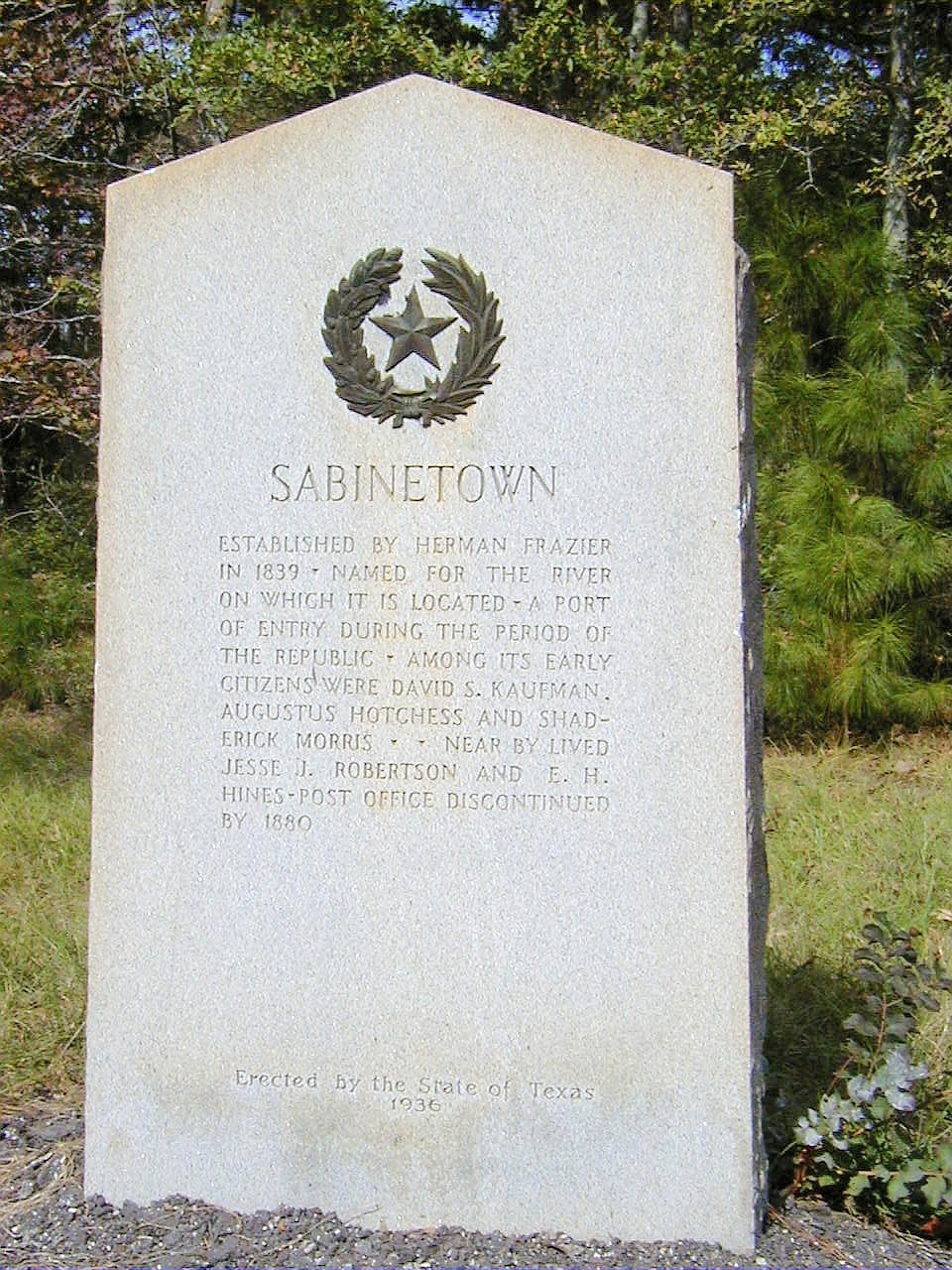
|
LOCATION: 11 mi.
east of Hemphill via FM 83, then north on FM 3382 -- Erected 1936
|
|
| |
Sabine
Town Cemetery
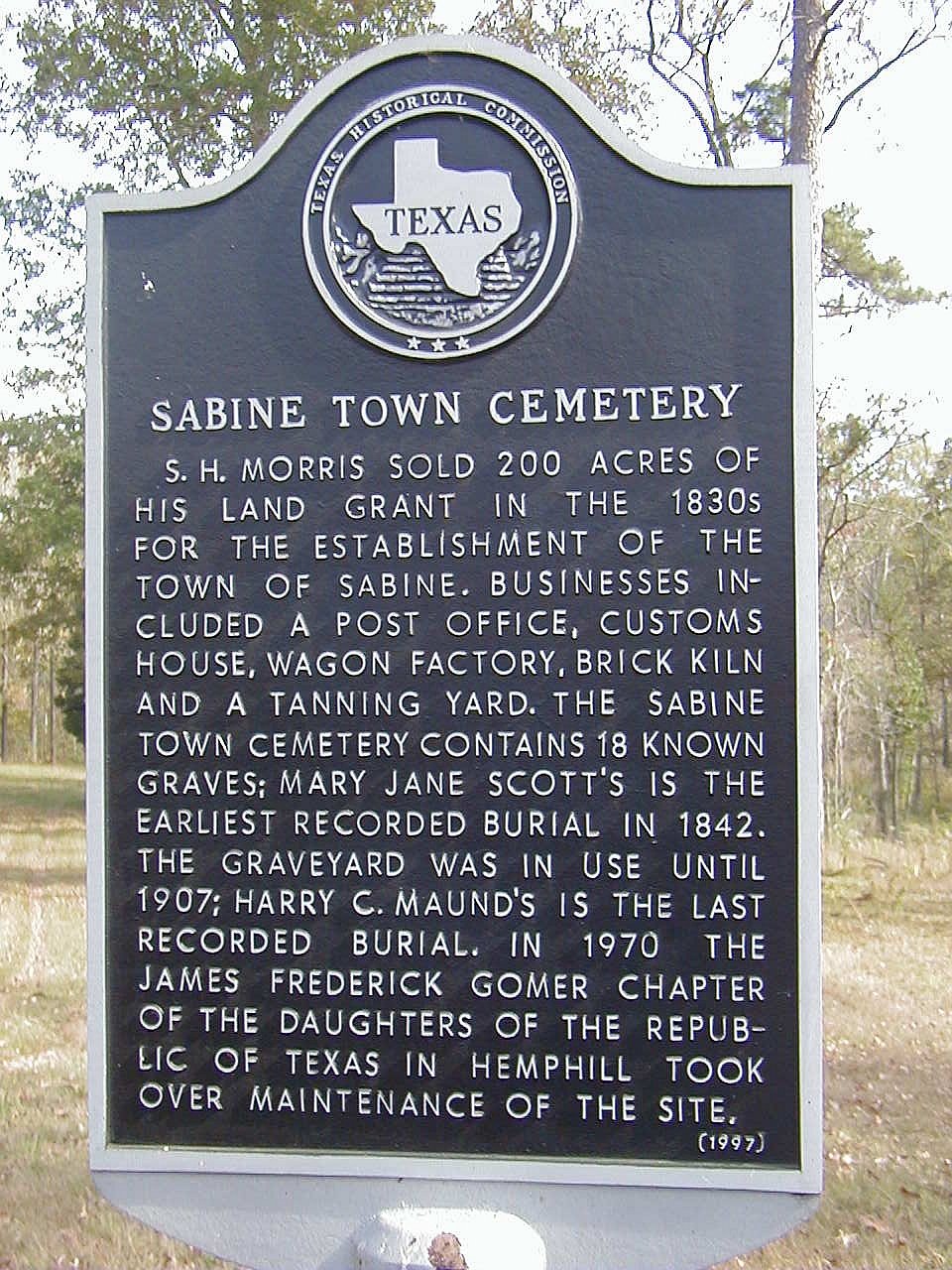
|
S.
H. Morris sold 200 acres of his land grant in the 1830s for
the establishment of the town of Sabine. Businesses included a
post office, customs house, wagon factory, brick kiln and a
tanning yard. The Sabine Town Cemetery contains 18 known graves;
Mary Jane Scott's is the earliest recorded burial in 1842. The
graveyard was in use until 1907; Harry C. Maunds is the last
recorded burial. In 1970 the James Frederick Gomer Chapter of the Daughters
of the Republic of Texas in Hemphill took over maintenance of
the site.
LOCATION: 11 mi. east of Hemphill via FM 83 \, then FM 3381 N
to Monument Dr., right down road for .25 mi., take first right --
Erected 1997
|
|
| |
Scurlock Cemetery
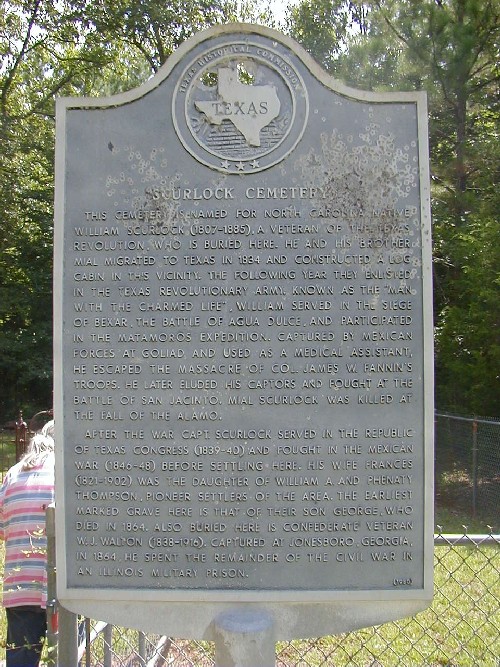
|
This
cemetery is named for North Carolina native William
Scurlock (1807-1885), a veteran of the Texas
Revolution, who is buried here. He and his brother Mial
migrated to Texas in 1834 and constructed a log cabin in this
vicinity. The following year they enlisted in the Texas
Revolutionary army. Known as the "Man with the Charmed
Life," William served in the Siege
of Bexar, the Battle
of Agua Dulce, and participated in the Matamoros
Expedition. Captured by Mexican forces at Goliad
and used as a medical assistant, he escaped the massacre of Col.
James W. Fannin's troops. He later eluded his captors and fought
at the Battle
of San Jacinto. Mial
Scurlock was killed at the fall of the
Alamo.
After the war Capt. Scurlock served in the Republic of Texas
Congress (1839-40) and fought in the Mexican War (1846-48) before
settling here. His wife Frances
(1821-1902) was the daughter of William
A. and Phenaty Thompson, pioneer settlers of the area. The
earliest marked grave here is that of their son George, who died
in 1864. Also buried here is Confederate veteran W. J. Walton
(1838-1916). Captured at Jonesboro, Georgia, in 1864, he spent the
remainder of the Civil War in an Illinois military prison.
LOCATION: Town of Geneva -- Erected 1980
|
|
| |
Mial
Scurlock
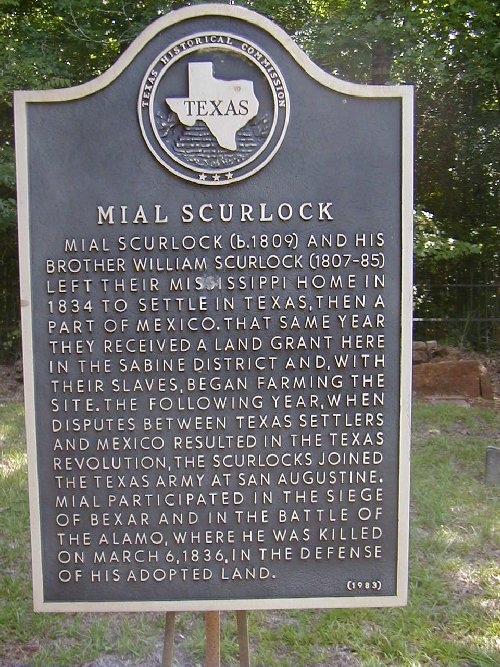
|
(b.
1809) and his brother William
Scurlock (1807-85) left their Mississippi home in 1834 to
settle in Texas, then a part of Mexico. That same year they
received a land grant here in the Sabine District and, with their
slaves, began farming the site. The following year, when disputes
between Texas settlers and Mexico resulted in the
Texas
Revolution, the Scurlock's joined the Texas army at San
Augustine. Mial participated in the Siege
of Bexar and in the
Battle
of the Alamo, where he was killed on March 6, 1836, in the
defense of his adopted land.
LOCATION: Town of Geneva -- Erected 1983
|
|
| |
Springhill
Cemetery
|
The
first person known to have been interred here was William Isaac
Pace in 1837. The Pace home was located on this site, and
according to local history the family established a Methodist
church and a school, significantly contributing to the development
of the Springhill community for which the cemetery was named.
Other pioneer families represented here include the Bennett,
Campbell, Conner, Cooper, Davidson, Davis, Dent, Easley, Ferguson,
Hyden, Jacks, Tatom and White families. Maria Ann Davis Pace
(1812-1909) lived to be nearly 100 years old, as did William F.
Stanley (1869-1968). The graves include veterans of the War of
1812, the Texas revolution, the Mexican War, the Civil War, World
War I, World War II, the Korean War and the Vietnam War.
LOCATION: 3.5 mi. W of Hemphill on FM 83; 1.5 mi. S on gravel
road -- Erected 1999
|
|
| |
Francis
Marcus Weatherred
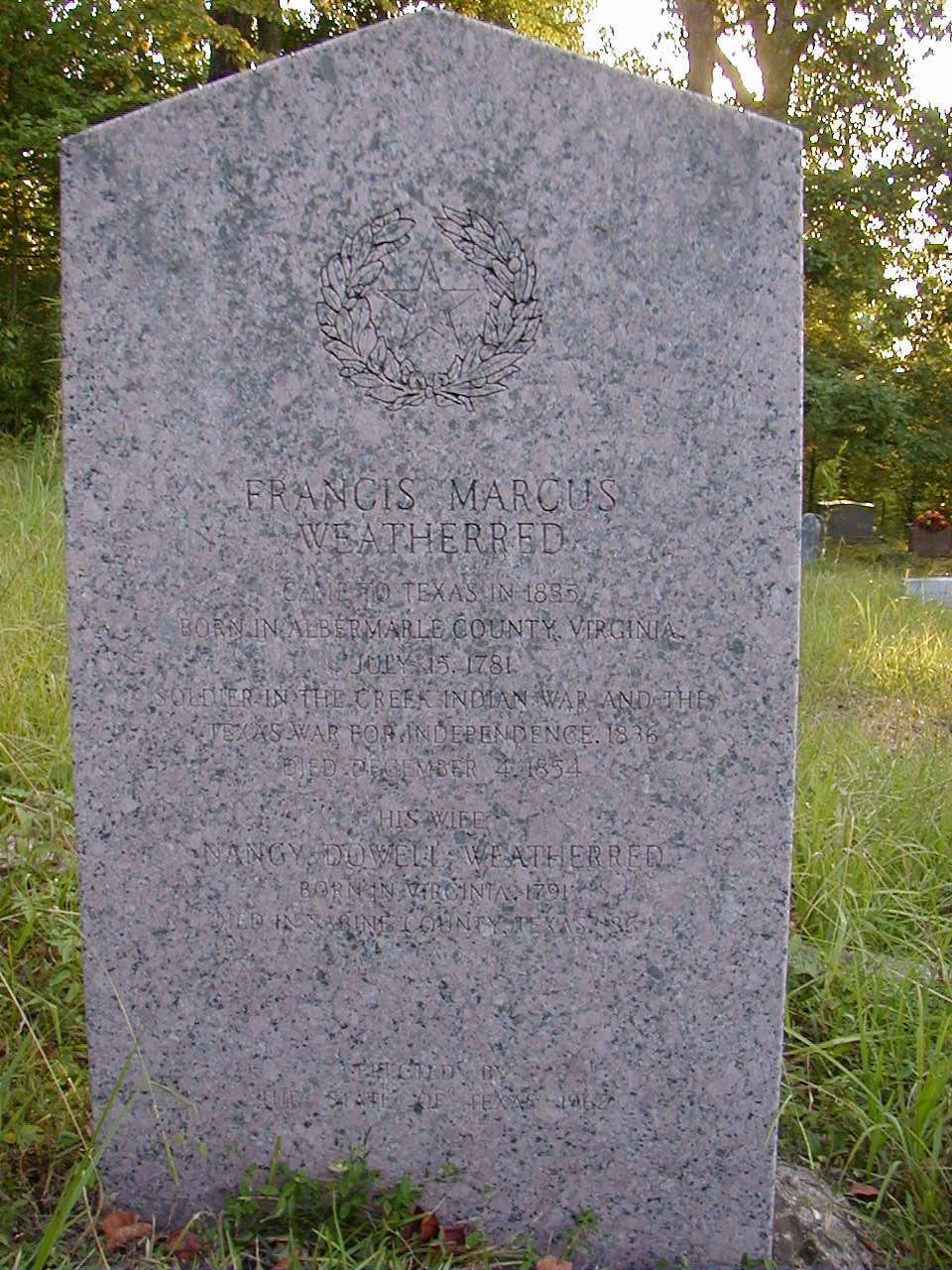
|
Grave
Marker (Star and Wreath)
Came to Texas in 1835. Born in Albermarle County, Virginia,
July 15, 1781. Soldier in the Creek Indian War and the Texas War
for Independence, 1836. Died December 4, 1854. His wife Nancy
Dowell Weatherred, born in Virginia, 1791; died in Sabine County,
Texas, 1864.
Erected by the State of Texas, 1962
LOCATION: Town of Milam - north on N. Vernon Rd. off SH 21,
west side of Milam
|
|
 |
|
 |

|